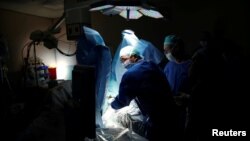Men with early prostate cancer whose doctors monitor their situation, as opposed to treating the cancer, have the same long-term survival rates. The finding was the outcome of a large British study comparing so-called “watchful waiting” with cancer treatment.
The ProtecT or Prostate Cancer Trial enrolled more than 82,400 men between the ages of 50 and 69. Of these, more than 1,600 men tested positive for early prostate cancer. They were followed for 10 years between 1999 and 2009.
They were randomized to receive active monitoring, radiation or surgery. The research teams at the University of Oxford, the University of Bristol, and nine other centers in Britain, investigated mortality rates, cancer spread and the side effects of treatment.
The researchers found that regardless of whether a man with early prostate cancer underwent treatment with radiation or surgery or was simply monitored, there was virtually no difference in terms of survival after a decade. In all three instances, 99 percent of the participants were still alive ten years later, if the cancer was localized.
But the study did find that there was less progression of cancer among men in the treatment groups than in men whose disease was simply monitored. The cancer spread in one in five men who were not treated compared to less than one in ten in those who received surgery or radiation.
The findings of the ProtecT study were published in the New England Journal of Medicine.
Otis Brawley, Chief Medical Officer at the American Cancer Society, welcomed the findings. However, he suggested it will still be difficult to convince some men to forego treatment for prostate cancer.
“If you are diagnosed and you are observed in this study, 44 percent [of men] at 10 years still had not gotten any treatment. About 20 percent got treatment because their tumor was progressing or growing in size. But then there’s another 36 percent, literally a third of the men, who were in the observation arm threw up their arms at some point in time and said 'I can’t take being watched while I have cancer. I want treatment,'” said Brawley.
Side-effects of treatment
The British study found downsides to treatment. Men in the surgery group experienced urine leakage and difficulties with their sex lives after the operation to remove their prostate glands, called a prostatectomy, compared to men in the active monitoring or radiation group. Those who underwent radiation had more bowel problems.
Brawley said the study’s findings validate his own views on treatment for small prostate cancers.
“For most of my career, I’ve been writing papers on my concern that we’ve been overpromising in terms of the value of screening and aggressive treatment for prostate cancer. I do think that there is a place for it,” he said. “This actually provides some data to show that we really ought to be circumspect about policies for screening and treatment for prostate cancer.”
In the United States, the U.S. Preventive Services Task Force has recommended against routine the PSA or prostate specific antigen test to screen for prostate cancer. The concern has been that there is a high rate of false positives or a detection of small tumors that never progress.
The American Cancer Society recommends that men talk to their doctors about the pros and cons of PSA screening for prostate cancer.







